Earthquake Early Warning - Blog
2023-10-13: EEW topic at Understanding Risk symposium

This year's Understanding Risk (URBC) symposium was focussed on an evaluation of risk reduction strategies, particularly with respect to earthquakes, floods, and wildfires. URBC symposia employ creative approaches, including panel discussions with audience participation, incorporation of Indigenous knowledge sharing, and the use of artists (through visual notes to capture key points in an easily understood format) to convey scientific concepts. These techniques and the diversity of participants leads to dynamic, productive discussions on disaster risk reduction practices.
This was an ideal venue for NRCan's Alison Bird to introduce Emergency Managers, Critical Infrastructure Operators, and engineers to the Earthquake Early Warning (EEW) system being developed for at-risk regions of Canada. The timing of the symposium, allows these groups to prepare their organizations, facilities, and communities to take safe response actions as a result of EEW alerts, which will become available in 2024. The symposium encouraged discourse between knowledge holders and practitioners, enabling NRCan to glean the needs of future technical and practical users of EEW alerts, which will facilitate the success of the EEW system.
2023-10-06: What to do when in a theatre or stadium during an earthquake
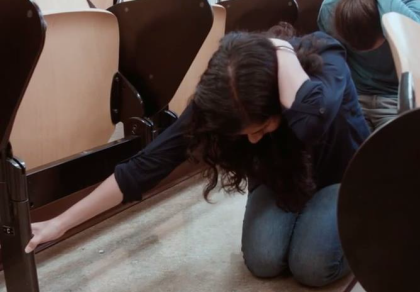
Earthquakes can strike anywhere, anytime – even when you’re at a film or a sporting event. If you’re in a stadium or theatre when you feel shaking or receive an Earthquake Early Warning alert, Drop, Cover, and Hold on. Drop to the ground between the rows of seats or, if not possible, stay in your seat and bend over. Cover your head and neck with your arms. If possible, Hold on by gripping the leg of a chair with one arm, keeping the other over your head and neck. Stay in this position until the shaking stops, and close your eyes and mouth to protect yourself from dust and debris.
2023-09-28: What to do when in a store during an earthquake

Earthquakes can strike anywhere, anytime – even when you're in a shop. As soon as you feel shaking or receive an Earthquake Early Warning alert, Drop, Cover and Hold On. Move away from heavy items on shelves, stay low and only crawl a short distance if cover is available. If there's no cover nearby, to protect yourself from falling objects, find an accessible alternative, such as an overturned shopping cart, a clothes rack, or inside a pallet rack (used in warehouse stores).
2023-09-21: What to do when in bed during an earthquake
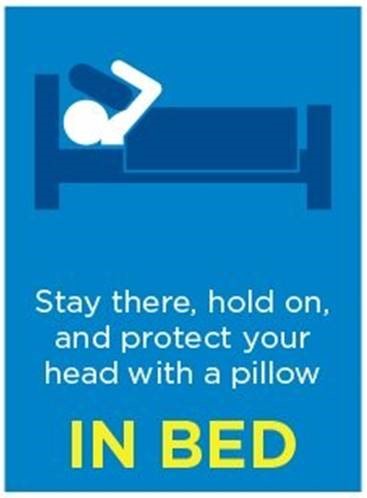
There is approximately a 35% chance you will be in bed during an earthquake, so it is a good idea to practise what to do if there when you experience shaking or receive an Earthquake Early Warning alert. The recommended response is to Stay, Cover, and Hold on. Stay in bed, turn onto your stomach, cover your head with your pillows, and hold on.
Pictures are likely to fall during an earthquake, so should be removed from over the head of any beds. Additionally, do not situate your bed under a window as they can shatter. Finally, keep a pair of sturdy shoes, flashlight, and dust mask accessible as there is likely to be broken glass and other hazards after a strong earthquake, plus it could be dark as power outages are common.
2023-09-14: What to do when in a wheelchair during an earthquake
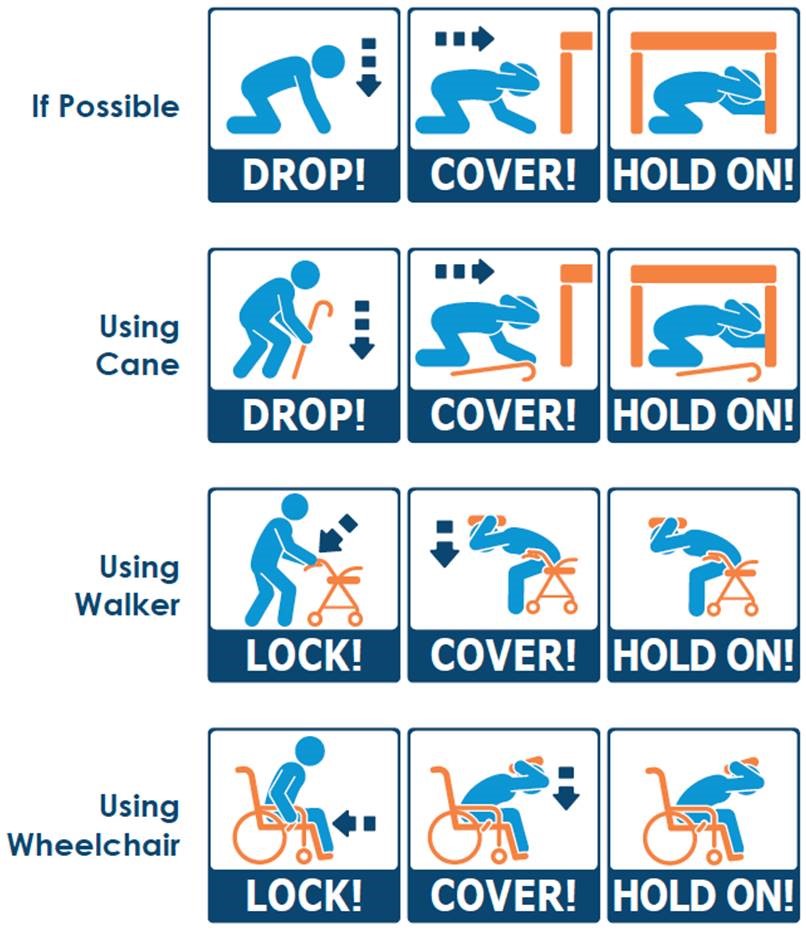
People with limited physical ability may have trouble responding to earthquake shaking, or to an Earthquake Early Warning alert, with the recommended “Drop, Cover, and Hold on” actions. The graphics, above, depict some alternative actions to take. If you are in a wheelchair or using a walker when you feel shaking or receive an alert, turn so that you will be facing away from windows and other hazards, then Lock the wheels, Cover your head and neck with your arms, if possible, and Hold on. It is advisable to practise these actions in advance, so that they become instinctive. Register for this year's practice drill at: www.ShakeOutBC.ca (BC), www.grandesecousse.org (Quebec and eastern Ontario; in French only), and www.shakeout.org/yukon/ (Yukon).
Finally, it is best to “secure your space” beforehand (see blog post from 2023-08-10).
2023-09-07: What to do when driving during an earthquake
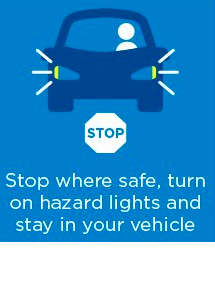
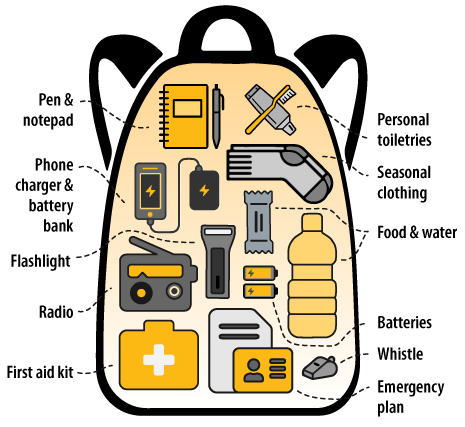
If you experience an earthquake whilst driving, it can seem as though there is something wrong with your car. Shaking trees, powerlines, and lamp standards are good indicators that you might be experiencing an earthquake. You may also receive an Earthquake Early Warning alert, before feeling any shaking. The best response in these situations is to Stop, Brake, and Stay. Slow down and pull over somewhere safe, avoiding overpasses, powerlines, bridges, and old (especially brick or stone) buildings. Turn off the engine and secure the handbrake. Stay in the car until the shaking stops. If a power line falls onto your vehicle, remain inside until a trained person can remove it. If you are trapped in your vehicle for any reason, turn on your emergency flashers.
After the shaking stops, listen to the radio and heed directions from officials. Keep emergency response routes clear and be aware of potential hazards, such as downed powerlines, damaged roadways, and other obstructions. If you are in a potential tsunami inundation zone, move to higher ground on foot and stay there until directed otherwise by authorities.
It is a good idea to keep a 'grab'n'go' emergency kit in your vehicle; advice on what to put into such a kit can be found here: Get Prepared.
UBC Co-op student assists with EEW's Indigenous engagement efforts
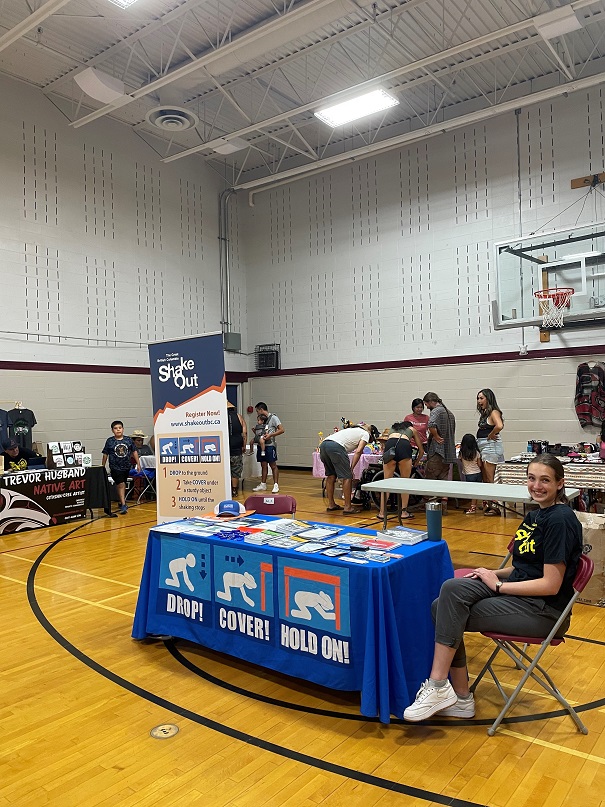
University of British Columbia co–op student, Marleigh MacLaren has just completed a productive work-term, as NRCan's Communications Assistant for the Earthquake Early Warning programme. She has designed a new display for the Haida Gwaii museum, which will include regionally-specific information on earthquakes, tsunami, and earthquake early warning. She also contributed to preparing engagement materials and activities, including several as part of a large public education campaign on EEW; the project is funded by NRCan and is being led by BC's Ministry of Emergency Management and Climate Readiness. Finally, Marleigh supported ShakeOutBC activities this summer, including hosting a booth at the annual Yellow Wolf Pow Wow held by Tsartlip First Nation in July.
2023-08-25: Co-op student helps assess the EEW system

As the Earthquake Early Warning (EEW) System is developed and NRCan's EEW data center processes earthquakes in "test" mode, the system is continually being assessed. University of Waterloo cooperative student, Bianca Angheluta, worked with supervisor Stephen Crane to develop assessment software, which automatically produces "EEW System Functionality Reports".
These reports provide a summary of the earthquakes the EEW system processed or omitted. The reports provide detailed information on each event, including the stations which contributed to the analysis, the corresponding seismograms, and the accuracy of the events' magnitude, epicenter location, and origin time. In other words, the reports show how well the EEW system is performing and are regularly reviewed by seismologists.
2023-08-21: What to do when outside during an earthquake
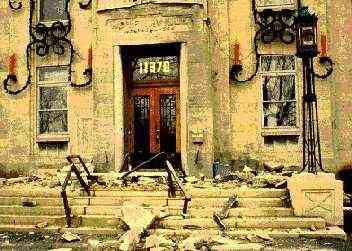
If you are outside and experience shaking (or receive an Earthquake Early Warning alert), it is best to stay outside, move to an area clear of hazards, then crouch down, and cover your head and neck with your arms. It is advisable to stay away from buildings (especially old, brick or stone structures), large objects, utility wires, and other hazards. The area near the exterior walls of a building can be dangerous, as windows, facades, and architectural details often topple.
Register for this year's ShakeOut earthquake drill in: BC at ShakeOutBC, Quebec at GrandeSecousse (in French only), Yukon at ShakeOut Yukon, and elsewhere at ShakeOut.